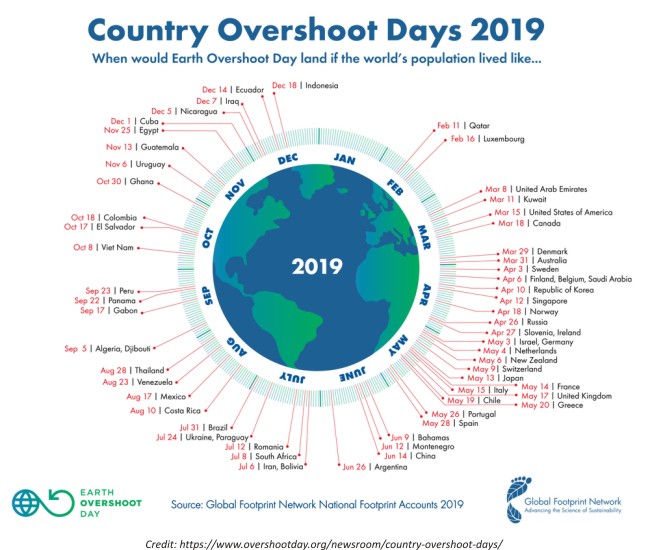|
Earth Overshoot Day: A Glimpse
Resource
efficiency has largely been recognised as an engine to attain
all-inclusive socio-economic growth through sustainable means. It,
therefore, becomes imperative that it is promulgated amongst lawmakers
and citizens alike, which is further essential for its smooth
implementation. It might be argued that a logical starting point for
sensitising the masses could be by introducing the concept of Earth
Overshoot Day (EOD). This article intends to do just that by providing a
glimpse into the fundamental aspects and significance of EOD. As a concept, EOD was first developed by Andrew Simms of the New Economics Foundation (NEF) and has subsequently been used by its partner organisation, the Global Footprint Network (GFN) to raise awareness concerning earth’s limited resource availability and the level and impact of humanity’s sustained exploitation. Accordingly, EOD (previously named Ecological Debt Day) serves as a critical indicator of our continued survival on this overburdened blue planet. Simply put, it refers to the calculated date (of a calendar year) on which humanity’s resource consumption for the year exceeds earth’s capacity to regenerate those resources (nature's budget) that year. EOD is determined using a simple formula that entails dividing the amount of natural resources produced by earth in a particular year (world’s biodiversity) by the humanity’s demand for natural resources for that year (ecological footprint) and multiplying the result with the number of days in that particular year. Both the world’s biodiversity and ecological footprint are calculated each year using the latest available data, updated computing methodology and further quantified by applying a standardised unit termed as global hectares (gha). For instance, based on the above formula, GFN had determined that the EOD last year (2018) fell on 1st August, a day ahead compared to 2017. This implies that we had already exhausted last year's available resource budget on that date and were living in a period of 'ecological debt’ for the remaining year. During the past decade, the EOD has been steadily moving to an earlier date in the year; from being calculated in 2007 as 26th October to in 2018 falling on 1st August. It remains to be seen at what date the EOD lands this year. Calculations are still ongoing. At present, humanity requires an equivalent of 1.7 Earths to satisfy its current rate of resource consumption, with more than 80% nations (mostly developed) living beyond their means. In contrast, only 0.7 Earths would be required if the entire world were to exist in accordance with living standards of developing nations. Further, it has been determined that an equivalent of four to five Earths would be needed in order to maintain the living standards of most developed countries (like the US, UK and most Western European nations). However, in the near future and considering its current rate of consumption, India alone would require around 2.5 Earths. Humanity’s current rate of resource exploitation has been compared to running a ‘Ponzi scheme’ with most countries plundering our planet’s future resources for ‘sustenance’. This unendurable process of perpetual misuse is bound to be short-lived, potentially leading to socio-economic collapse. This presents an alarming scenario and should ideally stimulate us towards adopting sustainable, environmentally benign practices in every sphere of existence.
The Earth Overshoot Day (EOD) doesn't necessarily have to keep falling ahead year on year. Experts have suggested some key science-based solutions to reverse its trend and drive it backwards. Embracing Resource Efficiency is considered by many as a key strategic approach for a sustainable future. It can help in striking the right balance between our developmental needs and abating the negative externalities associated with resource use. Other solutions include following a vegetarian diet, reducing our carbon footprint and stabilising population growth, among others. Forecasts claim that replacing around 50 percent of meat consumption with a vegetarian diet could move the EOD back by 5 days or a 50% reduction in atmospheric CO2 emissions could move it back by 93 days.
It is
within us to not let the past, but the choices we make, determine our
future. And only by drawing humanity’s four biggest strengths vis-à-vis
foresight, innovation, determination and compassion can we affect a
turnaround and help build a better world.■
Kranav Sharma
|
